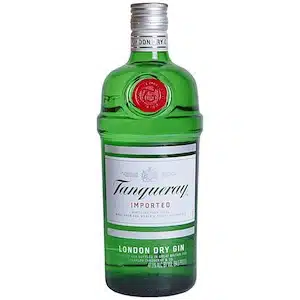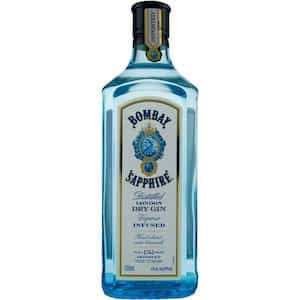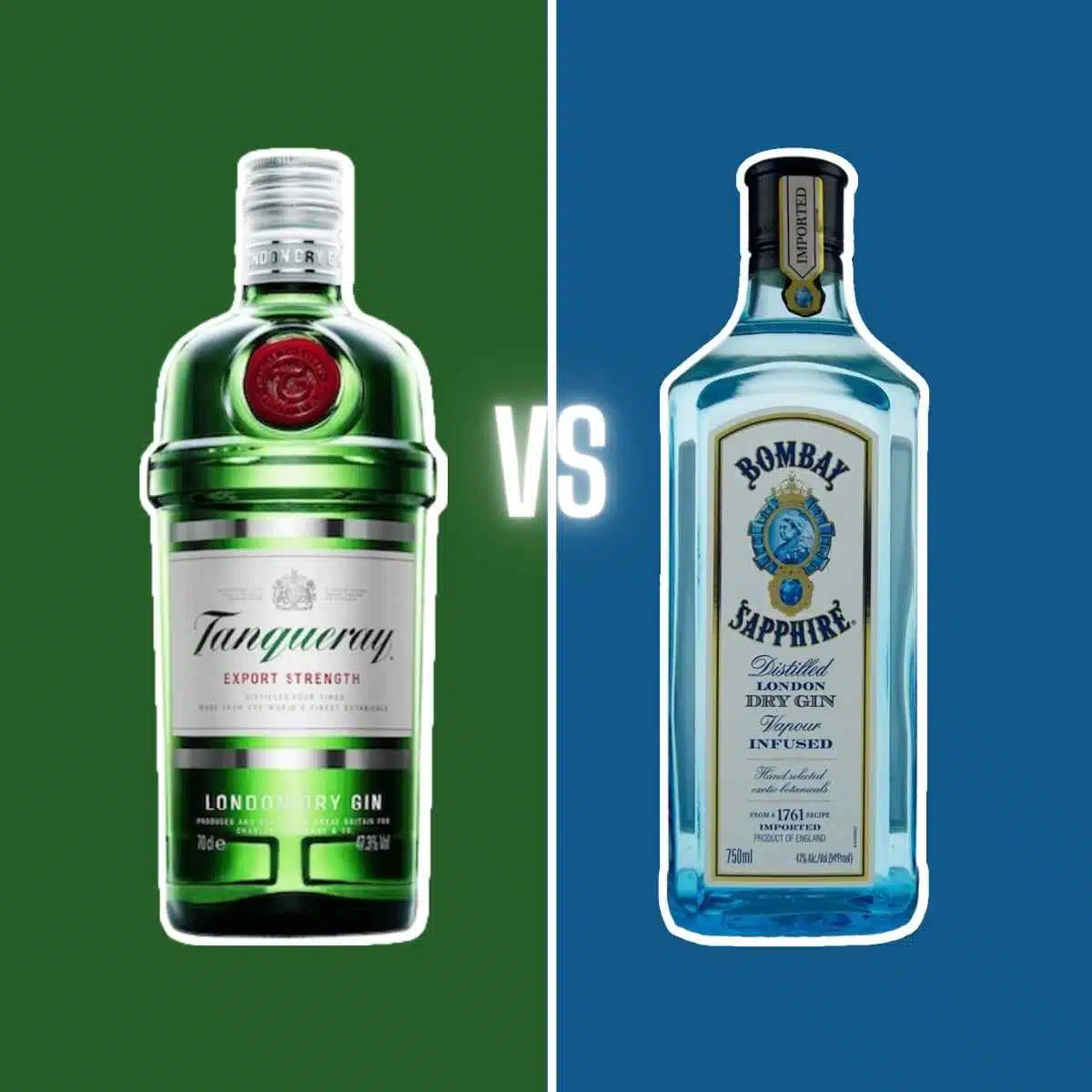If you're new to gin, you might have a hard time finding the best gin for your Gin & Tonic. Most people recommend starting with the traditional options, and so do we. But even when concentrating on the more classic bottles, there are plenty of options; -and Tanqueray and Bombay Sapphire are two that immediately come to mind.
In 1830, Charles Tanqueray introduced Tanqueray Gin. Today, It's made at the same distillery as Gordon’s Gin, at Cameron Bridge Distillery near Edinburgh, Scotland. Tanqueray is known for its unique taste of piney juniper and lemon zest, having an alcohol content of 47.3% (94.6 proof). This London Dry Gin costs $15 to $20 per bottle.
Bombay Sapphire was launched by wine merchants IDV much later, in 1987. It boasts a complex taste from 10 botanicals like juniper, coriander, and citrus peel. Compared to Tanqueray, Bombay Sapphire's alcohol content is significantly lower 40% (vs. 47.3%). Bombay distills its gin at Laverstoke Mill Distillery in Hampshire, England, and it also costs $15 to $20 per bottle.
Other established gin brands include Beefeater, Gordon's, Plymouth Gin, plus many others like Hayman's, Hendrick’s Gin, and so on. Here, we want to make a side-by-side comparison of Tanqueray Gin vs. Bombay Sapphire - both among the top 5 choices for London Dry Gin.
Key Takeaways
- Tanqueray Gin and Bombay Sapphire are two London Dry Gins with differing flavor profiles.
- The alcohol content of Tanqueray is higher (47.3% vs. 40%), yet it costs the same as Bombay Sapphire ($15-$20).
- Bombay Sapphire has a more modern and complex flavor profile when compared to juniper-heavy Tanqueray.
Tanqueray vs. Bombay Sapphire - Comparison Table
| Bombay Sapphire | Tanqueray | |
|---|---|---|
| ABV | 40% (47.3% in the US) | 40% (AU, NZ, and CA), 43.1% (UK & EU), 47.3%(US) |
| Proof | 80 (94 in US) | 80 (AU, NZ, and CA), 86.2 (UK & EU), 94.6 (US) |
| Country | England | Scotland |
| Price | $15 - $20 | $15 - $20 |
| # of Botanicals | 10 | 4 |
| Dominant flavors | Juniper, herbs, citrus, and floral notes | Piney juniper and lemon zest |
| Introduced | 1986 | 1830 |
| Owned by | Bacardi | Diageo |
Tanqueray Gin

- ABV: 47.3%
- Distilled at: Cameron Bridge Distillery near Edinburgh, Scotland
- Price per bottle: $15 - $20
- Taste: Juniper, pine, lemon zest
History & Origin
First launched in 1830 by Charles Tanqueray, this classic London Dry Gin recipe is produced in the same distillery as Gordon's Gin; -at Cameron Bridge distillery near Edinburgh.
Tanqueray includes just four botanicals to produce a juniper-heavy Gin with a fresh nose and dry palate full of juniper and citrus. It is among the highest-ABV options and makes an excellent Gin and Tonic.
Taste
No other Gin has such a distinct juniper aroma as Tanqueray Gin. The palate is also juniper-forward, with spicy notes in the background.
- Nose: Strong and piney notes of juniper like no other Gin, intriguing hints of lemon zest, and angelica.
- Palate: Dominant notes of juniper complemented by cinnamon, coriander, and angelica root.
- Finish: Long and warm finish with hints of juniper and spicy notes.
Botanicals & Production process
Tanqueray London Dry Gin uses only four different botanicals. However, they still create a remarkably complex flavor profile with just those four ingredients.
The production process is quite unique as the botanicals are added to neutral grain spirit and distilled straightaway. Other brands and products typically let the ingredients blend and steep in alcohol for a few hours or days.
The four botanicals used to make Tanqueray Gin are:
- Juniper
- Angelica root
- Licorice (or liquorice)
- Coriander
Use in cocktails
The strong juniper notes in Tanqueray make it an ideal base for gin cocktails with a classic profile. Our preferred drinks to make with it are a Dry Martini, Gin Sour, and, naturally, a Tanqueray and Tonic.
The best way to garnish a Gin Tonic made with Tanqueray is simply a wedge of lime. That perfectly highlights the lime and lemon flavors in the gin and goes beautifully with the pronounced juniper notes.
Bombay Sapphire Gin

- ABV: 47%
- Distilled at: Laverstoke Mill in Laverstoke, England
- Price per bottle: $15 - $20
- Taste: Juniper, floral, citrus, herbs
History & Origin
Bombay Sapphire was launched in 1986 by English wine-merchant IDV, which by then belonged to Grand Metropolitan. Only 11 years later, when Grand Metropolitan and Guinness merged to become Diageo, the company was sold to Bacardi.
Bombay Sapphire is best known for its striking blue bottle design. The brand is now owned by Bacardi and is one of the youngest competitors when it comes to classic Gin brands.
Their Sapphire Gin features ten different botanicals, making it more aromatic on the nose and delivering spiced, peppery, and citric notes to the nose and palate. It's a worthy alternative to other classic brands should you be looking for something less juniper-heavy.
Taste
The overall taste of Bombay Sapphire is well-balanced, with distinct acidic notes from the lemon peels that go along with coriander and juniper. It's much milder in juniper than Bombay Dry Gin.
- Nose: Peppery with notes of coriander and citrus.
- Palate: Mild with a gentle heat; spicy, earthy, and floral notes pair with hints of sweetness, citrus, and juniper.
- Finish: Quite a long finish with dominant notes of juniper, coriander, and lemon.
Botanicals & Production process
Bombay uses a blend of ten different botanicals to flavor their iconic Sapphire Gin. Instead of steeping them in neutral grain spirit, Bombay Sapphire infused flavors with a technique called vapor infusion extraction.
That means that the gin is flavored during the distillation. The botanicals are placed in a basket, and once the alcohol evaporates, it passes these baskets and is infused with the flavors before it turns liquid again.
The botanicals used in Bombay Sapphire Gin are:
- Almonds
- Angelica root
- Cassia bark
- Coriander
- Cubeb berries or cubeb pepper
- Grains of paradise
- Juniper berries
- Lemon peel
- Licorice root
- Orris root
Use in cocktails
Its balanced flavor profile with prominent yet not overpowering juniper notes make Bombay excellent in many classic Gin drink recipes. We preferably use it in a Dry Martini, Gin Gin Mule, and in a classic Gin and Tonic.
Served in a G&T, Bombay Sapphire is best garnished with a slice of lemon and fresh mint.
Which works best in classic Gin cocktails
Both Tanqueray and Bombay Sapphire are ideal for most traditional gin cocktails. Bombay has a more modern flavor profile, while Tanqueray is a classic London Dry Gin with distinct juniper notes.
So which of the two gins should be the first choice for which gin cocktail?
1. Negroni
The Negroni cocktail is an old recipe combining gin, sweet vermouth, and Campari. The drink has a bittersweet flavor profile and is commonly made with London Dry Gin. While you can make it with Tanqueray, a more citrus-forward gin like Bombay Sapphire (or Tanqueray 10) works slightly better.
Gin to choose to make a Negroni: Bombay Sapphire
2. (Dry) Martini
The Martini, or Dry Martini, is one of the oldest gin cocktails there is. The drink is a combination of 5 parts gin to one part dry vermouth, and benefits from classic flavor profiles and juniper-heavy gins. This time, my recommendation is Tanqueray. There are many bartenders and spirits experts, including me, that claim that a Tanqueray Martini is one of the best.
Gin to choose to make a Dry Martini: Tanqueray
3. Gin and Tonic
Last but not least, let's talk about the most popular gin highball - the Gin and Tonic. Choosing one gin over the other here is almost impossible. Nevertheless, in order to make a recommendation, I am being diplomatic. If you prefer classic gins with a dominant juniper flavor, choose Tanqueray. If you prefer a more modern gin, go for Bombay Sapphire.
Gin to choose to make a Gin and Tonic: Tanqueray Gin for classic juniper-driven G&T, Bombay Sapphire Gin for a modern, citrusy drink
Conclusion
The battle of Tanqueray vs Bombay Sapphire is mainly decided by the consumer. If you like a Gin with dominant juniper notes, Tanqueray is your best option. It turns the classic juniper-forward flavor profile of London Dry Gins into a high-class Gin.
If you're new to Gin or aren't a fan of overly juniper-dominant spirits, Bombay Sapphire is the better choice. The flavor profile is more balanced with more pronounced citrus and spice notes.

